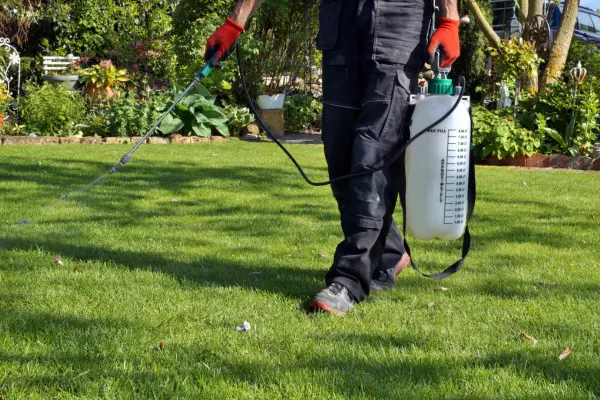Keeping your lawn healthy and free of fungal diseases is crucial for that lush, green look. Fungicides play a vital role in this, but just as important as using the right product is applying it at the right time.
Fungicide application isn’t just about reacting to disease—timing is everything when it comes to protecting your grass.
In this article, we’ll break down when to apply fungicide to lawn for the best results and share tips to keep your lawn fungus-free year-round.
Signs Your Lawn Needs Fungicide
Before you can decide when to apply fungicide, it’s essential to recognize the signs of fungal infection. Here are some common symptoms that suggest your lawn might need a treatment:
Yellow or brown patches: Discolored areas, often circular or irregular, can be an early sign of fungal infection.
Leaf spots: Small, dark spots on individual grass blades may indicate leaf spot disease.
Thinning or wilting grass: If your grass starts to thin out or appears wilted even when watered, it could be suffering from a fungal infection.
Mushrooms: While mushrooms aren’t harmful themselves, their presence often signals the presence of fungal spores in the soil.
When to Apply Fungicide to Lawn

When it comes to applying fungicide, timing is everything. Here’s a breakdown of the best times to apply fungicide based on the season and the condition of your lawn.
Early Spring (Preventative Care)
The best defense is a good offense, and that’s especially true for preventing fungal diseases. Applying a pre-emergent fungicide in early spring can prevent fungal spores from germinating. Most lawns are prone to fungus when moisture is high, and new growth is vulnerable. Early spring applications help reduce the risk of developing common fungal issues like snow mold or brown patch.
When to apply: Apply pre-emergent fungicides when soil temperatures reach around 60°F. This is typically in March or April, depending on your region.
What to use: A broad-spectrum fungicide such as propiconazole is ideal for early spring.
Note: Pre-emergent fungicides are preventative and won’t cure existing infections. If you notice symptoms of fungal disease before spring, switch to a curative fungicide.
Mid to Late Summer (When Conditions Favor Fungi)
As temperatures rise and humidity increases, lawns become more susceptible to fungal infections. Hot, sticky summer days are perfect for diseases like brown patch or dollar spot to take hold. Mid to late summer is the time to be proactive with fungicide applications, especially after long periods of rain or if your lawn is shaded.
When to apply: Apply fungicide during warm weather when night temperatures stay above 60°F. This is usually from June through August.
What to use: Products containing chlorothalonil or azoxystrobin work well for summer applications.
Pro Tip: For lawns in humid regions, it may be necessary to reapply fungicide every 14-21 days during the summer to keep diseases at bay.
Fall (Post-Fungicide Care)
Fall applications are all about preparing your lawn for the winter months ahead. Fungal spores can remain dormant in the soil and reactivate in spring, so a late-season application can help prevent that. Cooler temperatures, combined with dew on the grass, can trigger the spread of fungal diseases like rust or red thread.
When to apply: Apply fungicide in late September or October, depending on your region.
What to use: Look for a fungicide with myclobutanil or thiophanate-methyl for fall use.
Fall applications also help protect your lawn as it enters dormancy, reducing the chances of over-winter fungal outbreaks.
How to Apply Fungicide Properly

Proper application of fungicide is just as crucial as the timing. Follow these steps to ensure you’re applying it correctly:
Steps to Apply Fungicide:
Prepare your lawn: Mow your grass to a manageable height, and remove any excess clippings or debris.
Mix fungicide properly: Follow the manufacturer’s instructions carefully when mixing the fungicide solution. Too little, and it won’t be effective; too much, and you risk damaging your lawn.
Choose the right tool: Use a garden sprayer or hose-end sprayer for even coverage. For larger areas, you may need a backpack sprayer.
Apply evenly: Apply the fungicide evenly across the lawn, making sure to overlap each pass slightly to avoid missed spots.
Reapply as needed: Depending on the product, reapplication might be necessary after 7-21 days, especially during the summer months.
Table: Suggested Fungicide Types and Uses
| Fungicide Type | Best for | Application Timing |
|---|---|---|
| Propiconazole | Preventative (Spring) | Early Spring |
| Chlorothalonil | Brown Patch, Dollar Spot | Summer |
| Myclobutanil | Fall protection | Fall |
| Azoxystrobin | General fungal control (Summer) | Summer |
Natural Alternatives to Fungicide
If you prefer to avoid chemical fungicides, several natural options can help manage fungal diseases. Here are a few effective alternatives:
Neem oil: A natural antifungal, neem oil can be sprayed on lawns to control fungal spores.
Baking soda solution: Mixing baking soda with water and a bit of dish soap can help combat powdery mildew and other fungal diseases.
Compost tea: Spraying compost tea on your lawn helps introduce beneficial microbes that keep harmful fungi in check.
While natural alternatives may not be as powerful as chemical fungicides, they can be effective when used preventatively and combined with good lawn care practices.
Conclusion
Knowing when to apply fungicide to your lawn can make all the difference in maintaining its health and beauty. By applying fungicide in early spring, summer, or fall, and following the proper application techniques, you’ll protect your lawn from fungal infections and enjoy a lush, green space year-round. Don’t forget to pair fungicide use with healthy lawn care practices like proper watering, mowing, and aeration for the best results.
FAQs
How often should I apply fungicide?
It depends on the product and the severity of the fungal disease. Preventative treatments are typically applied every 14-21 days during periods of high risk.
Is fungicide safe for pets and children?
Most fungicides are safe once dry, but always check the label for safety instructions. Keep pets and children off the lawn until the fungicide has dried completely.
Can I apply fungicide in winter?
Fungicide applications in winter aren’t usually necessary, as fungal diseases tend to go dormant. However, preventive fall applications can help prevent issues come spring.

